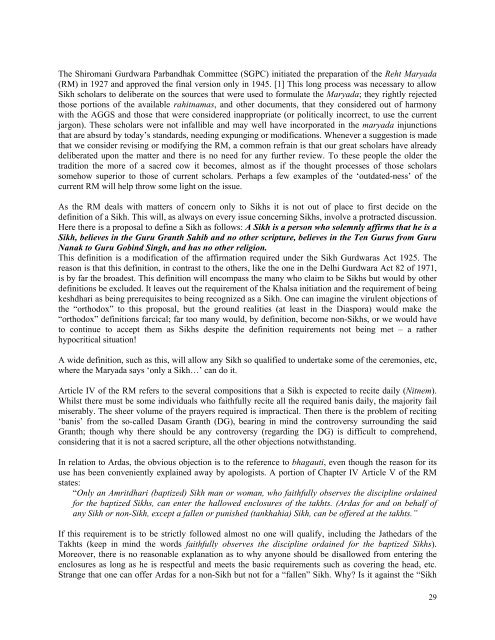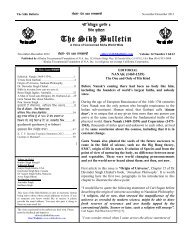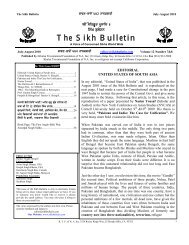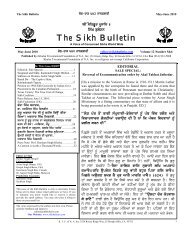Selected Editorials - The Sikh Bulletin
Selected Editorials - The Sikh Bulletin
Selected Editorials - The Sikh Bulletin
You also want an ePaper? Increase the reach of your titles
YUMPU automatically turns print PDFs into web optimized ePapers that Google loves.
<strong>The</strong> Shiromani Gurdwara Parbandhak Committee (SGPC) initiated the preparation of the Reht Maryada<br />
(RM) in 1927 and approved the final version only in 1945. [1] This long process was necessary to allow<br />
<strong>Sikh</strong> scholars to deliberate on the sources that were used to formulate the Maryada; they rightly rejected<br />
those portions of the available rahitnamas, and other documents, that they considered out of harmony<br />
with the AGGS and those that were considered inappropriate (or politically incorrect, to use the current<br />
jargon). <strong>The</strong>se scholars were not infallible and may well have incorporated in the maryada injunctions<br />
that are absurd by today’s standards, needing expunging or modifications. Whenever a suggestion is made<br />
that we consider revising or modifying the RM, a common refrain is that our great scholars have already<br />
deliberated upon the matter and there is no need for any further review. To these people the older the<br />
tradition the more of a sacred cow it becomes, almost as if the thought processes of those scholars<br />
somehow superior to those of current scholars. Perhaps a few examples of the ‘outdated-ness’ of the<br />
current RM will help throw some light on the issue.<br />
As the RM deals with matters of concern only to <strong>Sikh</strong>s it is not out of place to first decide on the<br />
definition of a <strong>Sikh</strong>. This will, as always on every issue concerning <strong>Sikh</strong>s, involve a protracted discussion.<br />
Here there is a proposal to define a <strong>Sikh</strong> as follows: A <strong>Sikh</strong> is a person who solemnly affirms that he is a<br />
<strong>Sikh</strong>, believes in the Guru Granth Sahib and no other scripture, believes in the Ten Gurus from Guru<br />
Nanak to Guru Gobind Singh, and has no other religion.<br />
This definition is a modification of the affirmation required under the <strong>Sikh</strong> Gurdwaras Act 1925. <strong>The</strong><br />
reason is that this definition, in contrast to the others, like the one in the Delhi Gurdwara Act 82 of 1971,<br />
is by far the broadest. This definition will encompass the many who claim to be <strong>Sikh</strong>s but would by other<br />
definitions be excluded. It leaves out the requirement of the Khalsa initiation and the requirement of being<br />
keshdhari as being prerequisites to being recognized as a <strong>Sikh</strong>. One can imagine the virulent objections of<br />
the “orthodox” to this proposal, but the ground realities (at least in the Diaspora) would make the<br />
“orthodox” definitions farcical; far too many would, by definition, become non-<strong>Sikh</strong>s, or we would have<br />
to continue to accept them as <strong>Sikh</strong>s despite the definition requirements not being met – a rather<br />
hypocritical situation!<br />
A wide definition, such as this, will allow any <strong>Sikh</strong> so qualified to undertake some of the ceremonies, etc,<br />
where the Maryada says ‘only a <strong>Sikh</strong>…’ can do it.<br />
Article IV of the RM refers to the several compositions that a <strong>Sikh</strong> is expected to recite daily (Nitnem).<br />
Whilst there must be some individuals who faithfully recite all the required banis daily, the majority fail<br />
miserably. <strong>The</strong> sheer volume of the prayers required is impractical. <strong>The</strong>n there is the problem of reciting<br />
‘banis’ from the so-called Dasam Granth (DG), bearing in mind the controversy surrounding the said<br />
Granth; though why there should be any controversy (regarding the DG) is difficult to comprehend,<br />
considering that it is not a sacred scripture, all the other objections notwithstanding.<br />
In relation to Ardas, the obvious objection is to the reference to bhagauti, even though the reason for its<br />
use has been conveniently explained away by apologists. A portion of Chapter IV Article V of the RM<br />
states:<br />
“Only an Amritdhari (baptized) <strong>Sikh</strong> man or woman, who faithfully observes the discipline ordained<br />
for the baptized <strong>Sikh</strong>s, can enter the hallowed enclosures of the takhts. (Ardas for and on behalf of<br />
any <strong>Sikh</strong> or non-<strong>Sikh</strong>, except a fallen or punished (tankhahia) <strong>Sikh</strong>, can be offered at the takhts.”<br />
If this requirement is to be strictly followed almost no one will qualify, including the Jathedars of the<br />
Takhts (keep in mind the words faithfully observes the discipline ordained for the baptized <strong>Sikh</strong>s).<br />
Moreover, there is no reasonable explanation as to why anyone should be disallowed from entering the<br />
enclosures as long as he is respectful and meets the basic requirements such as covering the head, etc.<br />
Strange that one can offer Ardas for a non-<strong>Sikh</strong> but not for a “fallen” <strong>Sikh</strong>. Why Is it against the “<strong>Sikh</strong><br />
29
















